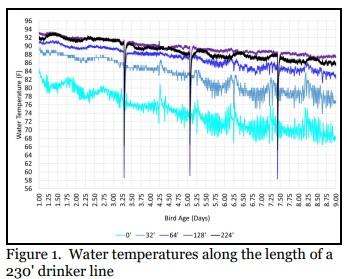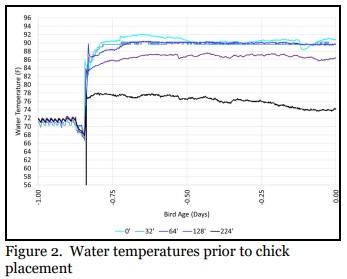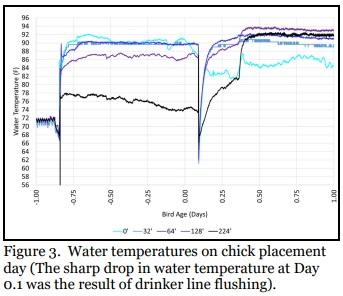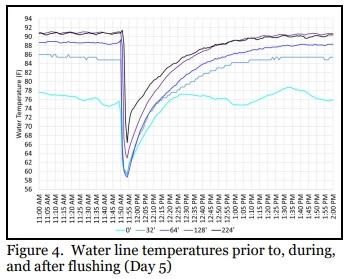Controlling Water Temperature During Brooding
Published: September 1, 2022
By: Michael Czarick, Brian Fairchild / Department of Poultry Science - University of Georgia
Though there is a wide range of opinions on the optimal drinking water temperature for young chicks, the fact is farm managers actually have a very limited ability to control the temperature of the water their chicks are drinking because, for all practical purposes, it is determined by house air temperature. If the air temperature is 90°F, the water will be around 90°F. If the air temperature is 80°F, the water temperature will be around 80°F, regardless of what temperature the water enters the house. This is the result that due to very low consumption rates, the water within a drinker line moves incredibly slowly, on average less than one foot per minute, which means that it can take over an hour for the water to simply travel the first 50' of a 200' - 300' drinker line! Since the water in a drinker line is almost stationary, and drinker lines are not insulated, the water doesn’t have to travel far before it warms up, or in some rare cases cools down, to room temperature....typically within 40' to 60' of entering a drinker line.

Figure 1 illustrates water temperatures along the length of a 230' drinker line during the first week of a wintertime flock in a 40' X 500' broiler house. The temperature of the water entering the house’s control room from the ground was approximately 55°F. During the 30' trip from control room to the first nipple on the drinker line, the water warmed from 55°F to between 70°F and 80°F, depending on house air temperature at the time. By the time the water reached the nipples 64' from the beginning of the drinker line, it had warmed to essentially air temperature. Previously conducted farm studies in which the incoming water temperate was in the high forties or low sixties documented a similar trend.
It may be of interest to note the fact that it typically takes between forty to sixty feet for the water within a drinker to warm to air temperature is the reason that litter beneath the beginning of a drinker line tends to get wetter during cold weather than other areas of a house. As warm, moist air comes in contact with the cool drinker line, moisture in the air condenses upon the drinker line and drips onto the floor. The colder the drinker line, the more likely condensation will form on the drinker line and the wetter the litter beneath the drinker line will become. Once the water within a drinker line warms to room temperature, condensation formation ceases and the litter beneath the drinker line becomes drier.
Since the water flows so very slowly along the length of the drinker line, water in a drinker line will actually heat up or cool down depending upon the environmental conditions along the length of the drinker line. Figure 2 illustrates the water temperatures beginning the day before the chicks were placed. House air and drinker line water temperatures were approximately 70°F, 36 hours prior to chick placement. Twenty-four hours prior to chick placement (Day -0.8) house air temperature was increased to 90°F and drinker line water temperatures followed, increasing to between 85°F and 90°F, with a notable exception of those near the end of the drinker line, where they only increased to approximately 75°F. The lower water temperatures recorded near the end of the drinker line were due to the fact that the air temperature near the end of the drinker line was only in the mid-seventies as a result of loose-fitting tunnel fan shutters. When the house’s circulation fans were turned on (Day 0.3) and the air near the tunnel fans warmed to near 90°F, the drinker line water temperatures increased similarly (Figure 3).


The fact that the water within a drinker line is essentially stationary during brooding and drinker lines are not insulated also means that flushing water lines has a very short-lived effect on temperature of the water the birds are drinking. The instrumented drinker line was flushed for five minutes on Days 0, 3, 5, and 7. Flushing the drinker line has the least effect on water temperatures nearest the end of the line. This is because during flushing, as the water moved from the beginning to the end of the drinker line, it was warmed by the air in the house. That being said, regardless of location along the length of the drinker line, water temperatures returned to within five degrees of their pre-flush levels within 30 minutes.
The relatively quick recovery of water temperatures after flushing illustrates that even if the drinker lines are filled within 30 minutes of chick arrival, the water will achieve room temperature by the time the chicks take their first drink. In addition, if water lines are periodically flushed during brooding to assure water freshness/cleanliness, the accompanying short-lived decrease in water temperature would not likely adversely affect young chicks.

Though it may be potentially beneficial to be able to precisely control the temperature of the water the birds are drinking during brooding, the fact is that house air temperature will tend to determine this temperature. Whether the incoming water temperature is “hot” or “cold” it will tend to assume house air temperature within 40' - 60' of entering a drinker line. Though flushing drinker lines can decrease water temperatures, the effect is very transitory. This doesn’t mean that there may not be benefits to flushing water lines during brooding (i.e., flushing stagnate water from the line), but controlling water temperature is not one of them.
This article was originally published in Poultry Housing Tips, Volume 34, Number 9, 2022. University of Georgia, College of Agricultural and Environmental Sciences Cooperative Extension (https://www.poultryventilation.com/).
Related topics:
Authors:


Recommend
Comment
Share
1 de octubre de 2022
When building our first broiler house I gave much consideration as to how to provide cool drinking water for brooding chicks. All I could come up with was storing and transporting water underground and constantly flushing the lines with the return to source also underground. Plus insulating the lines. We came to the conclusion that it was not worth doing and that it is more important to regularly flush the lines (every 4 hours) to maintain palatability of the water. The addition of vitamin when flushing also improves palatability.
Recommend
Reply

Would you like to discuss another topic? Create a new post to engage with experts in the community.














